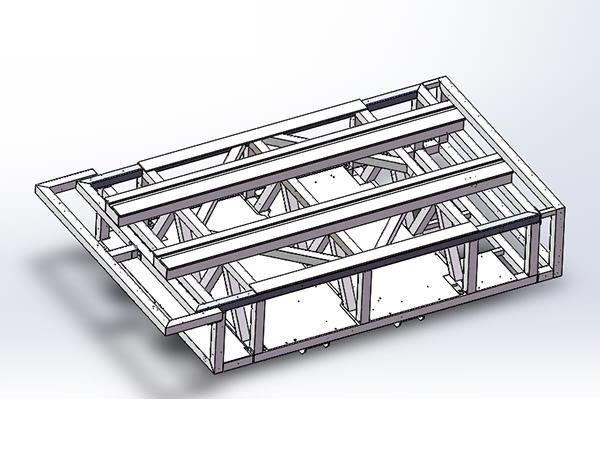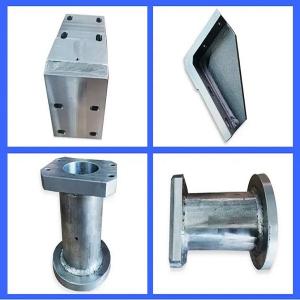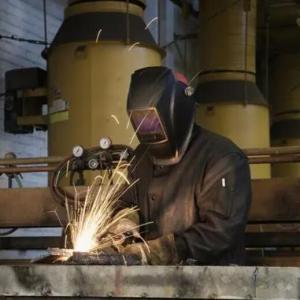Welded structural parts
Welded structural parts
Welded structure refers to the common metal structure that is most suitable for manufacturing by welding. Due to the wide variety of welded structures, their classification methods are also different. For example, according to the manufacturing method of semi-finished products, it can be divided into plate welding structure, punching welding structure, etc.; according to the purpose of the structure, it can be divided into vehicle structure, hull structure, aircraft structure, etc.; according to the material thickness of welding parts, it can be divided into thin-walled structure Structure and thick-walled structure; according to the material type of the weldment, it can be divided into steel structure, aluminum structure, titanium structure and so on.
Metal Welding refers to a connection method in which two separated metal objects are connected by atomic or intermolecular bonding through appropriate means.
In product manufacturing, welding and thermal cutting are a very important processing technology. According to the statistics of industrialized countries, the steel used after welding only accounts for about 45% of the total steel output. Welding can not only solve the connection of various steels. It can also solve the connection of non-ferrous metal materials such as aluminum and copper. Therefore, it has been widely used in machinery manufacturing, shipbuilding, marine development, automobile manufacturing, oil chemical industry, aerospace technology, atomic energy, electric power, electronic technology and construction and other departments.
The welded structure has a series of advantages unmatched by other structures, mainly reflected in the following aspects:
1. The integrity of the welded structure is strong. Since welding is a connection between metal atoms, it has high rigidity and good integrity. Under the action of external force, it will not cause excessive deformation due to gap changes like other mechanical connections. Therefore, the strength and stiffness of welded joints can generally reach the same The base metal is equal or similar, and can withstand various loads with the base metal.
2. The welded structure has high strength and light weight. Welded structures are mostly made of rolled materials, which have strong impact load capacity, and the strength of steel is many times higher than that of building materials such as masonry and concrete. The strength of welded joints manufactured by modern welding technology is higher than that of base metal.
Parts or components of welded structures can be connected directly by welding without any additional connectors. Compared with the riveted structure, the mass with the same structure can be reduced by 10% to 20%.
3. The safety performance of the welded structure is high. Due to the good plasticity of steel, under normal circumstances, it will not cause sudden rupture and damage due to accidental overloading or local overloading, but a large deformation omen will appear in advance, so that remedial measures can be taken. Steel also has good toughness, strong adaptability to dynamic loads acting on the structure, and provides a reliable guarantee for the safe use of welded structures.
Within a certain stress range, the steel is in an ideal elastic state, which is in line with the basic assumptions used in engineering mechanics, so the calculation results are accurate and reliable to ensure the safe use of welded structures.
4. The compactness of the welded structure is good. Due to the tightness of the welded seam, the welded structure can ensure the air tightness and water tightness of the product, which is an indispensable and important condition for the normal operation of pressure vessels such as boilers, gas storage tanks, and oil storage tanks.
5. The economic benefits of the welded structure are good. Welded construction is more economical than rolling when using some profiles. For example, large I-beams (height greater than 700mm) welded with wide flat steel and steel plates are often cheaper than rolled sections.
Welded structure production generally does not require large, special and expensive equipment, low investment, quick results, easy to adapt to the production of different batches of products, fast and convenient product replacement, and good economic benefits.
Welded Structure ApplicationsEdit
Welded structures are widely used, mainly in the following aspects:
①The welding structure is suitable for the production of a particularly large range of dimensions. Not only micro-machine parts can be manufactured (using micro-welding technology), but also large-scale steel structures can be manufactured, especially suitable for products with large geometric dimensions and complex shapes, such as hulls, trusses, spherical vessels, etc. For large or super-large complex projects, the structure can be decomposed, the decomposed parts or components can be welded separately, and then welded into an overall structure through overall assembly.
②The structure of any shape can be manufactured, and the on-site installation can be realized.
③ It can realize the connection of dissimilar materials, such as the connection of dissimilar metals, the connection of metals and non-metals, etc., so that the material application of the welded structure is more reasonable.
Welded structure classification editing broadcast
1. Beam and beam system structure
The working characteristic of this type of welded structure is that the elements constituting the beam system are subjected to lateral bending. When a beam system (or frame structure) is formed by rigid connections of multiple beams, the stress situation of each beam will become more complicated.
2. Column structure
This type of welded structure is characterized by compressive stress or longitudinal bending stress at the same time. The cross-sectional shape of the structure is mostly "I"-shaped, "box-shaped" or tubular circular cross-section. Column-type welded structures are also commonly combined with various types of steel to form a so-called virtual-abdominal virtual-wall composite section. Using these forms can increase the moment of inertia, improve the stability of the structure, and save materials.
3. Trellis structure
It is composed of a series of tension or compression rods, and the rods are connected to each other in the form of nodes to form structures of various shapes, such as trusses, network rigid frames and skeletons.
4. Shell structure
This type of structure bears a large internal pressure, so the welded joints are required to have good air tightness, such as containers, receptacles, and pipes, etc., which are mostly welded with steel plates.
5. Skeleton structure
The shape of this type of structure is similar to the human skeleton, and it is mostly used for lifting and transporting machinery, which usually bears dynamic loads, so it is required to have the smallest weight and greater rigidity. structure. The raw materials of the skeleton and the lattice structure are mostly various types of steel, and sometimes the two types of structures are collectively referred to as the lattice truss structure.
6. Welded parts of machines and instruments
This type of structure is best suited to work under alternating or repeated loads. Therefore, precise dimensions are required for this type of structure to ensure the quality of the main components or instrument parts processed. Machine bases, fuselage, machine tool beams and gears, flywheels and instrument pivots that belong to this type of structure. This type of structure adopts steel plate welding or casting welding and forging welding combined process, which can solve the problem of insufficient casting and forging equipment capacity and greatly shorten the manufacturing cycle.
Basic issues to be considered during the fabrication of welded structures. While ensuring the quality of welded joints on structural components, in order to meet processing conditions, it is necessary to increase productivity and increase safety by improving the working environment during manufacturing. For welded structure fabrication technicians, it is an important responsibility to select appropriate materials, enrich processing equipment and skilled workers' processing technical capabilities.






